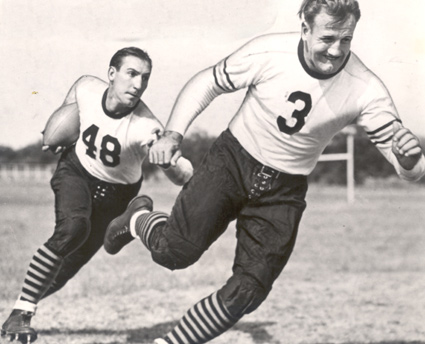Football and feathers
3/3/2011
A new "For Pete's Sake" blog appears each Thursday.
Okay, I thought I’d keep it light this week. So I’m going to write about feathers. You’ll be so entertained that you’ll send the link of this blog to a friend of yours who will then forward to another friend who emails that to yet another friend. Before you know it, we’ll have more fans come to Profootballhof.com and my bosses will be so pleased with the traffic that they’ll give me a raise. That, in turn, will make my wife happy and then that makes me pleasant so I can keep sharing interesting stories from pro football’s past! At least that’s how I see it.
Assuming you’re still with me, this week’s blog is about a player by the name of Beattie Feathers. Why Beattie Feathers? Because part of the Pro Football Hall of Fame’s mission is “to educate the pubic regarding the origin, development and growth of professional football …”
It’s my hope as I not so eloquently pointed out in the lead paragraph that we can attract more fans to the Hall of Fame website. After all, if you call yourself a football fan then you ought to have Profootballhof.com bookmarked so you can learn something new about the game every day.
Now back to the story of Beattie Feathers. The other day on our home page we had a trivia question which asked which player was the NFL’s first 1,000-yard rusher. The choices were Cliff Battles, Feathers, Red Grange or Steve Van Buren. Of course, you can probably figure out that the answer was Feathers. Yet the results to our trivia question had most fans picking Van Buren as the answer.

But, in 1934 the National Football League was moving into a new era. With that came the advent of official statistics being compiled and shared by the NFL and its clubs. Prior to that time, the numbers are bit sketchy. As it turns out, the stats from Feathers’ history-making season stood for some time before inaccuracy set it and incorrect figures were published for years. Finally, in the mid-1980s, Feathers accomplishment was once again recorded accurately.
The number in question was not about whether Feathers reached the 1,000-yard mark but centered on the number of times he carried the football and for exactly how many yards. An All-American halfback from the University of Tennessee, Feathers joined the “Monsters of the Midway” in 1934. Fortunate for him, he had a terrific supporting cast that helped him pave his way to history that rookie season. The Bears roster was stacked with future Hall of Famers like Bronko Nagurski, Grange, Link Lyman, Bill Hewitt, and monstrous lineman George Musso. They were coached by some guy named George Halas.
Not appearing as large of a player as reported, Feathers once admitted after being pressured that he was just 5’10 1/2” and 185 pounds. Newspaper reporters questioned how he could bang his way through opponents to amass such astonishing rushing yardage.
Quoted in his soft-spoken southern drawl obtained from growing up in Bristol, Virigina he simply surmised, “They just give me the ball and Ah get goin’. Guess the blockin’ is pretty good ahead of me.”
That it was as evidenced by the size of his lead blocker Nagurski (No. 3) in this photo from our archives.

Feathers reached the milestone mark despite the fact that he missed the final two games of the regular season, both against the Detroit Lions, with a shoulder injury.
Now, back to the discrepancy. The numbers fluctuated depending on the report. At season’s end there were accounts that had him credited with 107 carries for 1052 yards and touted his nearly 10-yard per rushing attempt average. But then the official count settled on 1,004 yards via 119 rushes. Sometime in the early ‘50s, the number of carries was changed to 101. That erroneous total was carried in the NFL record book for many, many years. Finally, an in-depth study on Feathers’ 1934 season deduced that the official count is 119 carries for 1,004 yards and 8 TDs. While his average wasn’t 10.0 it was a healthy 8.44 yards per carry. How has that rushing average stood up against the test of time? Well, no running back has ever had a single-season rushing average higher. In fact, the only NFL player ever to eclipse the season rushing average was quarterback Michael Vick who bested Feathers record by a mere 1/100th of a yard per rush when he gained 1,039 yards on 123 rushes in 2006 for the Atlanta Falcons.
Feathers claim to fame on the football field was reserved to that first season. Although he continued to play in the NFL for six more seasons with the Bears, Brooklyn Dodgers, and Green Bay Packers, he never came remotely close to the 1,000-yard mark. In fact, no one did.
The league had to wait 13 seasons before Van Buren became history’s second player to eclipse the 1,000-yard rushing mark in 1947 for the Philadelphia Eagles. By the way, he recorded 1,146 yards in 1949 to become the first player to have multiple 1,000-yard seasons. Another Hall of Famer, Joe “The Jet” Perry is the first player to have back-to-back 1,000-yard seasons when he reached the milestone mark for the San Francisco 49ers in 1953 and again in 1954.
Starting in 1958, a 1,000-yard rusher became the norm. Since that season, except for the strike-shortened 1982 season, there has been at least one 1,000-yard rusher every year.
NFL’s First 1,000-Yard Rushers
1934 – Beattie Feathers, Bears1947 – Steve Van Buren, Eagles
1949 – Steve Van Buren, Eagles; Tony Canadeo, Packers
1953 – Joe Perry, 49ers
1954 – Joe Perry, 49ers
1956 – Rick Casares, Bears
1958 – Jim Brown, Browns
1959 – Jim Brown, Browns; J.D. Smith, 49ers
Go back to all blog listings